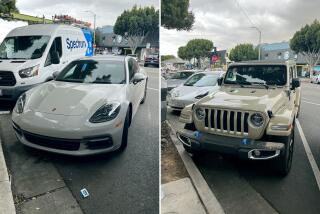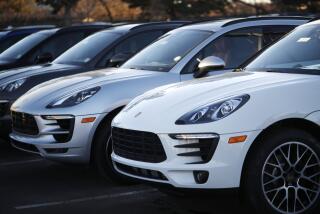The $54,000 Question
- Share via
Poor Porsche.
It has created an aristocracy among modern sports cars, sired a dozen Le Mans winners in its 44-year history, and followed a fixation with traditional design and proven technology that has made the marque synonymous with quality build, consummate driving pleasures and indelible snob appeal.
Yet Porsche continues to drown in its own affluence.
World sales have pitched on their face. In the United States, which accounts for about 60% of Porsche sales, numbers are down from 30,500 cars sold in 1986 to a dismal 4,400 last year. That’s worse than Suzuki.
In California--a nirvana for Porschephiles since the bathtub 356s of 1948--only 163 of the tony two-seaters sold during the first quarter of 1992. And that’s a drop of more than 35% from last year.
Why? Porsche prices. They stretch from a low of $40,000 to a high of $99,000, a point where most other products are measured by carats.
How come? An intractable combination of exchange-rate imbalances, U.S. luxury taxes, careless production costs, recession, a drift toward inconspicuous consumption--and an stubborn mind-set among Porsche’s ruling family. It has long dictated that its cars will remain ultra-exclusive and very up-market: Let critics eat cake.
It was only in February--after apparently accepting that Mazda (RX-7), Nissan (300ZX), Mitsubishi (4000GT) and even stodgy Dodge (Viper) are selling fast, exciting sports cars for much less--that the company announced its potential salvation: an entry-level Porsche that, like starter cars by BMW and Mercedes, should sell for a few Deutsche marks under $30,000.
The new car may be called the 966 and is reported to be a rear-engined, four-cylinder, 177-m.p.h. coupe with a 1995 launch date.
Meanwhile, Porsche’s entry-level car for 1992 is the 968 with a sticker price to make grown checkbooks weep: $39,850 for the base coupe and $54,000 for a convertible with Porsche’s patented automatic-manual Tiptronic transmission.
Our test car--a cobalt cabriolet with six-speed manual transmission--was, by today’s standards, somewhat short on luxuries. No leather seats. Only a single-disc CD. But it still costs $54,745.
Final financial footnote: The 3.0-liter 968 replaces the 2.5-liter Porsche 944 introduced in 1982 and the two-liter 924 of 1975. In 1985, a 944 cost between $20,000 and $25,000. Five years later, the basic price had doubled.
Yet as the 968 continues its parental tradition of outrageous pricing, it also sticks hard to the company’s reputation for building tight, beautifully coordinated sports cars with impressive technology rooted in a racing heritage.
Although only four cylinders and sans the benefit of artificial respiration, the engine delivers 236 horsepower. More important, the car produces 225 pound-feet of torque--the twisting moment or rotational effect of the engine--the highest of any non-turbocharged three-liter engine in the world.
The result is fast, flowing acceleration in the middle-speed ranges, precisely where most driving entertainment is enjoyed.
This little power plant also is equipped with counter-rotating balance shafts that remove the rock ‘n roll common to most four-cylinder engines. Under hard power, the twin shafts cradle the engine against vibrations until it feels more like a small, quite smooth V-6.
As with the antecedent 924s and 944s, the 968 is a front-engined, rear-drive, liquid-cooled car.
But unlike earlier vehicles, it comes with a six-speed gearbox, giving the 968 lankier legs and increased fuel economy when loafing along in sixth gear at thoroughly illegal speeds.
Otherwise, all the interesting driving, cruising and rushing overtakes will be done in the first five cogs. That makes the sixth gear something of a gimmick. And you certainly aren’t going to climb all the way into top gear and back down again on a routine commute from downtown to Diamond Bar.
The 968 is a very pretty car, bearing slightly bulbous traces of Porsche’s 928 luxury hot rod and some accents--particularly the five-spoke alloy wheels--from the 959 supercar. It hunches nicely forward and displays modern roundness with just enough styling cues from Porsches of yore.
The interior is cozy, with seats designed not simply for sitting, but for gently hugging a body when sporting blood stirs and a winding road becomes a succession of entrances, apexes and rapid exits.
At the same time, these posture-perfect seats will not herniate any discs on a long haul--such as from Los Angeles to Phoenix and back in two days, completed without once assuming the pretzel position.
The convertible top should be a model for anybody who wants to build the perfect cabriolet. Although the Mercedes 500SL has a lock on the ultimate operation, Porsche comes close with a quick, effortless, one-person maneuver involving two windshield catches and one power button. Even windows automatically lower as the canvas top hisses into its space behind the front seats.
And attaching the boot snaps is easier than fixing a button-down collar.
The 968’s dashboard design and instrument layout are fully functional. That’s a nice way of saying it’s a little stark, definitely short on frivolity, but very much in keeping with Porsche’s philosophy of paying only minimum attention to the internal scenery.
Porsche’s known preoccupation is with blurring scenery outside the vehicle. In this regard, the 968 is a beautifully mannered screamer.
Top up or top down, the car is built like a steel bucket, and there is zero flex to the chassis. Also, no quivering front fenders when road surfaces turn rutty. And precious little whistling and wind noise with the top up and the cockpit sealed.
Consistency. That the biggest trump card with the 968.
No matter speed nor maneuver, foot and hand pressures for braking, steering and power adjustment remain constant. So does the behavior of the car: generally neutral, with a hint of over-steer when leaning harder into corners.
In fact, the quicker the pace, the more consistent the 968’s mechanical response. That allows intuition--rather than conscious, and usually approximate, calculations--to enter the handling picture.
And should your intuitions get a little out of whack, driver- and passenger-side air bags are standard.
Weekend lovers had better be light travelers because trunk space in the Porsche 968 is more of a deep tray. The coupe is billed as a 2+2, but see it as a 2+1. In the convertible, there is package but not people room behind the seats.
It is clear that the 968 will be functioning as a stopgap for three years until the entry-level car appears.
The question is: Will Porsche’s fortunes and reputation survive the wait?
1992 PORSCHE 968
COST:
* Base, for coupe, $39,850.
* Convertible, as tested, $54,745. (Includes luxury tax, anti-lock brakes, passenger and driver-side air bags, power top, cruise control, six-speaker sound system with single disc CD, automatic air conditioning, power windows, etc.). ENGINE:
* 3.0 liter, 16-valve, four-cylinders, developing 236 horsepower. TYPE:
* Front-engine, rear-drive, two-seater sports car. PERFORMANCE:
* 0-60 m.p.h., as tested, 6.7 seconds.
* Top speed, manufacturer’s estimate, 148 m.p.h. CURB WEIGHT:
* 3,240 pounds. THE GOOD:
* Four-cylinder performance refined to the max.
* Consistent, predictable, high-speed handling.
* Best of old styling, most reliable of new technology. THE BAD:
* Obscene price.
* Porsche’s last stand? THE UGLY:
* The price.






